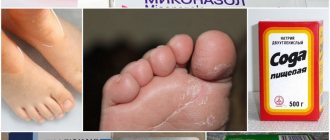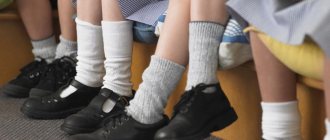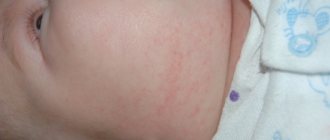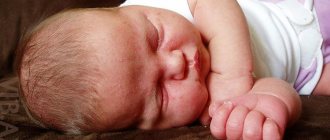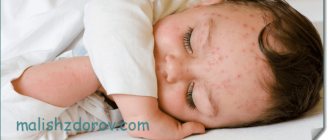The main causes of rashes, irritation and allergies on the butt
The butt, thighs and inguinal folds often become the main location of irritation and red rash in young children.
Rashes on the butt can take many different forms:
- diaper rash - inflammation of the skin due to prolonged contact with irritating substances, most often occurring in infants;
- spots of different colors;
- papules (nodules);
- bubbles with liquid inside;
- blisters are swellings on the skin without filling;
- ulcers and erosions, which later turn into sores.
The rash may appear as separate elements; if there are many of them, they look like a rash. Let's understand the reasons for the appearance of skin irritation on the buttocks in children; photos with explanations and a video from a famous pediatrician will help us with this.
Video from Dr. Komarovsky:
Poor nutrition
In infants, incorrectly introduced complementary foods often lead to the formation of an allergic ring in the anus, on the butt and on the legs. The photo shows red spots with severe swelling of the skin.
When breastfeeding, the baby's condition directly depends on the mother's nutrition. Consumption of highly allergenic foods - chocolate, citrus fruits, coffee - often affects the baby and leads to rashes.
A 2-year-old child’s diet is constantly expanding with the introduction of new products; you need to make sure that he receives only what is appropriate for his age.
Allergy ring
Diapers
The epidermis of a newborn is still loose, so it is easily damaged when bathing or swaddling. Even the most diligent mothers often face the problem of irritation.
In infants, skin lesions are in the nature of diaper rash and are associated with prolonged contact with urine, feces and lack of proper hygiene. Diaper rash is a local inflammation of the skin that is not infectious.
However, if left untreated, infection with staphylococcus or another pathogen may occur and pyoderma may develop. Diapers often contribute to this. They retain urine in which bacteria quickly multiply.
Urea irritates the skin and leads to skin damage. Diaper rash appears especially quickly in infants with diarrhea, since feces also irritate the skin.
Without natural ventilation, the body under the diaper gets wet and overheats. Imperfection of the sweat glands in infants is another provocateur of diaper rash.
Cheap diapers often do not meet safety requirements and contain dangerous components in their material. Among the diapers of famous brands there are many counterfeits.
Dermatitis in infants, which was previously called diaper dermatitis, can now safely be called diaper dermatitis.
How to avoid:
- change diapers regularly, without waiting until they become full;
- when changing a diaper, wash the baby with warm water and soap and wipe thoroughly until dry; sanitary napkins should be used only when traveling;
- choose the right size diaper - larger and smaller sizes are unacceptable;
- do not wear them all the time, put them on only when leaving the house;
- carefully care for skin folds, lubricating with cream and sprinkling with talcum powder;
- Give your child air baths every day for 30-60 minutes.
Sometimes the diaper itself causes irritation; you need to monitor the baby’s reaction. If rashes appear, choose diapers from a different brand.
Washing powder
Many mothers, trying to protect their children from numerous infections and ensure ideal cleanliness, often provoke the development of allergies and simple irritation due to washing powders that do not meet safety requirements.
The chemical compounds in their composition lead to the development of an allergy in the child, which is in the nature of dermatitis.
Once your baby is out of infancy, you can’t wash his clothes using conventional means. Children under 5 years of age, and if they are prone to dermatitis and older, need hypoallergenic household chemicals. We must also not forget about the need to rinse things thoroughly; when washing in automatic machines, you need to set the double rinse mode.
How to avoid:
- use baby washing powders;
- do not wash baby clothes with the rest;
- refuse bleaching and conditioners;
- Be sure to iron your clothes.
An allergy to washing powders can last a lifetime.
External stimuli
Any type of external influence can cause a rash on a child’s bottom. Allergic reactions in children almost always take the form of rashes.
Other types of reactions may also occur:
- food - in the form of signs of dyspepsia, digestive disorders;
- respiratory – cough, sore throat, runny nose;
- ocular – lacrimation, photophobia.
Children who have one of their parents with allergies are especially likely to suffer from allergies.
The most common allergens are:
- dust;
- pet hair;
- plant pollen;
- medications;
- household chemicals and cosmetics;
- food products, often the most ordinary ones.
To protect your baby, it is necessary to thoroughly clean and ventilate the rooms in which he sleeps and plays. Monitor your diet and stick to an age-appropriate diet.
Video from Dr. Komarovsky:
Rashes by age
An undeveloped immune system responds with different types of skin reactions to external influences.
To summarize, we can identify the main factors leading to rashes on the butt in children of different ages:
- Up to a year. Diaper dermatitis - exposure to urine and feces, overheating, increased sweating. Improper nutrition of the mother during lactation, incorrect complementary feeding.
- 2 years. Expanding the diet, insufficient toileting of the butt, wearing diapers.
- Children 3 years old. Problems with the potty may remain; going to kindergarten and outside increases contact and the possibility of infection with helminths.
- 4 years - 6 years. Children are actively involved in collective life. They use cosmetics – bath foam, creams. They receive sweets, chips, and chocolate as gifts. As their diet expands, the likelihood of developing food allergies increases. Visiting sports sections, swimming pools, clubs leads to the possibility of contact dermatitis and infectious diseases.
At an older age, the number of skin reactions in children decreases, but in some, the tendency to them continues even into adulthood.
What Causes Yeast Infection in Diapers?
The fungus Candida albicans is the main cause of yeast diaper rash (3) . The following factors can contribute to the entry of fungus into the diaper area (4)(5) .
- Diapers create a typical condition of wetness and friction in the baby's buttocks. These conditions promote the growth of fungus.
- Urine and feces can raise the skin's pH , making it an ideal environment for fungus to grow and multiply. Frequent bowel movements due to diarrhea may increase the risk.
- Don't change the diaper frequently and don't clean the area well.
- Infants who already have andida infection of the mouth or esophagus may be at greater risk because the fungus can be passed into the urine and stool.
- Good bacteria in the human body inhibit the growth of fungus. Direct use of broad-spectrum antibiotics or ingestion of milk by mothers who have taken antibiotics may increase the likelihood of a yeast infection.
- Fungi can grow and develop in areas with high levels of carbon dioxide , which are typically found in enclosed areas under standard disposable diapers.
Treatment of allergies and irritation in children
Skin rashes should not be left untreated. They cause discomfort to children and are often accompanied by itching. Damage to the deeper layers of the dermis may develop, and infection may occur.
Hives are accompanied by severe itching, and the youngest may develop a fever. You should not delay calling a pediatrician; only he can understand the reason for its appearance. If necessary, an examination by an allergist and nutritionist will be scheduled.
To treat irritation, local remedies are used that effectively relieve inflammation, swelling, and dry the skin.
Drugs used:
- Zinc ointment – contains zinc, petroleum jelly, fish oil. It fights well against diaper dermatitis, eczema, and allergic lesions. Dries the epidermis, kills infectious pathogens, and creates a protective film.
- D-panthenol . Increases the rate of tissue regeneration, protects against infection, softens and soothes itching.
- Desitin . It effectively prevents the development of skin reactions and is widely used to prevent diaper dermatitis. Retains its properties for several hours after application.
- Syntomycin ointment . It has an antibacterial effect and relieves inflammation well. Apply under bandages.
- Bepanten . Used to treat newborns. Restores tissue well, accelerates regeneration, protects against the aggressive effects of chemicals and urine.
Baths using herbs - chamomile, celandine, calendula, string - give a good effect. Many people prefer folk remedies.
Careful hygiene and the use of baby creams to prevent inflammation are also necessary.
Treatment of allergic dermatitis requires a different approach. The first point is to identify the dangerous product or substance. To do this, they use the elimination method - excluding products that are suspected of being allergens.
Skin tests to detect allergens are usually not performed before 6 years of age. Blood serum testing is possible.
When treating skin rashes on the butt of an allergic nature, the following is used:
- local remedies for relieving inflammation and itching - Fenistil, Elidel;
- antihistamines – Fenistil, Zyrtec;
- sorbents for removing toxins – Polysorb, coal, Enterosorb;
- hormonal drugs for severe reactions and the inability to overcome allergies - Flucinar, Fluorocort;
- immunomodulators;
- vitamins.
When treating allergic dermatitis, complex therapy is necessary, but it is symptomatic. It will not help cure allergies. It should be noted that many children outgrow their allergies as they get older. Reactions to the substance go away on their own with the strengthening of the immune system.
Video about medications for allergies in children:
Folk remedies
Some herbs have anti-allergenic properties. Especially raspberry decoction. Such drugs can be used both internally and externally. You can give your child this decoction to drink or bathe him in a bath with the addition of medicinal herbs.
No less effective is rosehip decoction. It should be used orally before meals 2 times a day. It is recommended to give your baby baths with sage infusion. It helps to cope with an allergic reaction in the form of a rash, especially red.
rebenokzabolel.ru
Allergic rashes
If a child has an allergy to his butt, then you need to carefully analyze all the changes that are happening around, including in nature. Perhaps the time has come for poplars, birches, cereal grasses, or such a formidable allergen as ragweed to bloom. Or you brought an animal into the apartment. Pay attention to air humidity, amount of dust and quality of cleaning.
Treatment consists of isolating the baby from the source of the problem. The reaction to repeated contact with allergens is expressed in the formation of spots and blisters, which increase in size and merge with each other.
How to apply redness to a child’s bottom: anti-inflammatory drugs
Other effective medications:
- D-panthenol is an antiseptic, soothes the skin and eliminates unpleasant pain.
- Zinc powder – has a soothing effect and eliminates excess moisture.
- Drapolene – a remedy for rashes, eliminates redness and itching
- Collection of anti-inflammatory herbs - useful for bathing and washing. This decoction softens the skin and relieves inflammation, without drying it out.
- Bathing salts have mild disinfectant properties.
- Syntamycin ointment is a “local antibiotic” ointment that eliminates inflammation and accelerates healing.
- Psilo balm – removes allergic rashes
- Baby cream – soothes the skin
babyben.ru


